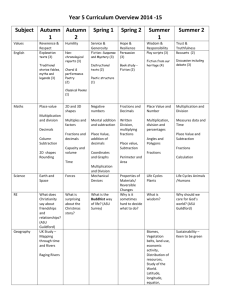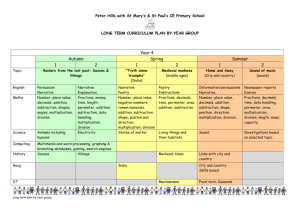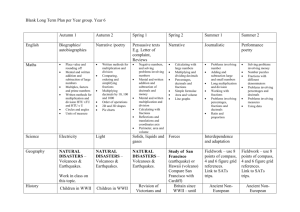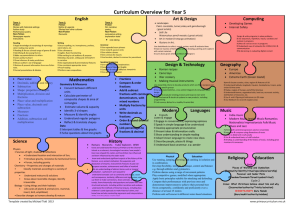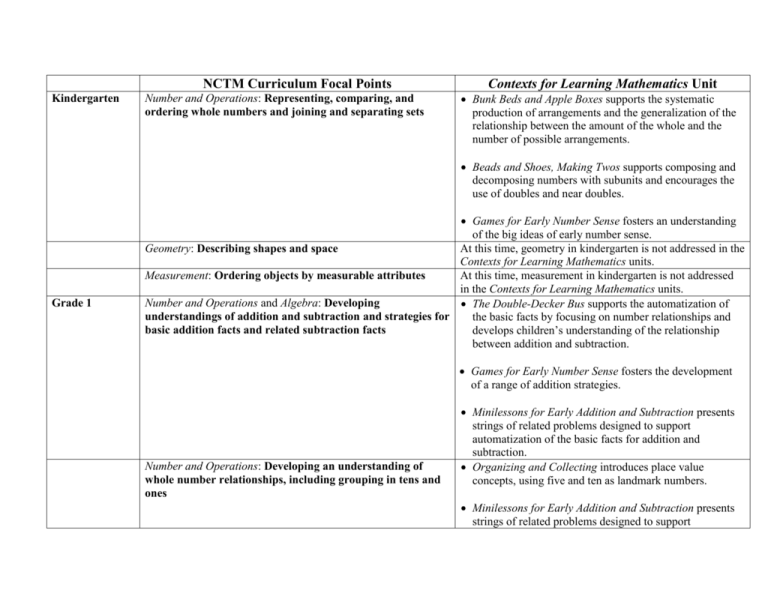
NCTM Curriculum Focal Points
Kindergarten
Number and Operations: Representing, comparing, and
ordering whole numbers and joining and separating sets
Contexts for Learning Mathematics Unit
Bunk Beds and Apple Boxes supports the systematic
production of arrangements and the generalization of the
relationship between the amount of the whole and the
number of possible arrangements.
Beads and Shoes, Making Twos supports composing and
decomposing numbers with subunits and encourages the
use of doubles and near doubles.
Grade 1
Games for Early Number Sense fosters an understanding
of the big ideas of early number sense.
Geometry: Describing shapes and space
At this time, geometry in kindergarten is not addressed in the
Contexts for Learning Mathematics units.
Measurement: Ordering objects by measurable attributes
At this time, measurement in kindergarten is not addressed
in the Contexts for Learning Mathematics units.
Number and Operations and Algebra: Developing
The Double-Decker Bus supports the automatization of
understandings of addition and subtraction and strategies for
the basic facts by focusing on number relationships and
basic addition facts and related subtraction facts
develops children’s understanding of the relationship
between addition and subtraction.
Games for Early Number Sense fosters the development
of a range of addition strategies.
Number and Operations: Developing an understanding of
whole number relationships, including grouping in tens and
ones
Minilessons for Early Addition and Subtraction presents
strings of related problems designed to support
automatization of the basic facts for addition and
subtraction.
Organizing and Collecting introduces place value
concepts, using five and ten as landmark numbers.
Minilessons for Early Addition and Subtraction presents
strings of related problems designed to support
Geometry: Composing and decomposing geometric shapes
Grade 2
Number and Operations: Developing an understanding of the
base-ten numeration system and place-value concepts
automatization of the basic facts for addition and
subtraction.
At this time, geometry in grade 1 is not addressed in the
Contexts for Learning Mathematics units.
Organizing and Collecting fosters an understanding of the
place value patterns that occur when making and adding
on groups of ten.
The T-Shirt Factory develops the standard algorithms for
addition and subtraction, and extends an understanding of
place value to three and four places.
Number and Operations and Algebra: Developing quick recall
of addition facts and related subtraction facts and fluency
with multidigit addition and subtraction
Minilessons for Extending Addition and Subtraction
presents strings of related problems designed to support
an understanding and use of base-ten numeration.
Measuring for the Art Show introduces the number line
model and develops efficient multidigit addition strategies
such as taking leaps of ten, splitting, and using landmark
numbers.
The T-Shirt Factory supports the development of
generalizable strategies for addition and subtraction.
Ages and Timelines employs the open number line to
guide learners toward computational fluency with
subtraction.
Trades, Jumps, and Stops introduces algebraic concepts
and strategies such as equivalence, exchanging equivalent
expressions, and undoing.
Minilessons for Extending Addition and Subtraction
presents strings of related problems designed to support
the development of a wide variety of efficient
Measurement: Developing an understanding of linear
measurement and facility in measuring lengths
Grade 3
Number and Operations and Algebra: Developing
understandings of multiplication and division and strategies
for basic multiplication facts and related division facts
computation strategies for double- and triple-digit
addition and subtraction.
Measuring for the Art Show explores distance as
measured as a series of iterated units and that units used in
measuring can vary in size, but the results will be
equivalent.
Groceries, Stamps, and Measuring Strips builds
sequentially from repeated addition to multiplicative
thinking and lays a framework for strategies that will
support automatization of the basic facts.
The Big Dinner supports use of the distributive property
with greater amounts. It also develops computational
fluency with whole-number multiplication and builds
automaticity of the multiplication facts.
Muffles’ Truffles explores big ideas in multiplication,
including the distributive, associative, and commutative
properties.
Minilessons for Early Multiplication and Division
supports automatization of the basic facts for
multiplication and division and develops a wide variety of
early computation strategies for larger numbers.
Number and Operations: Developing an understanding of
fractions and fraction equivalence
Geometry: Describing and analyzing properties of twodimensional shapes
At this time, fractions in grade 3 is not addressed in the
the Contexts for Learning materials. Field Trips and
Fund-Raisers explores the connection between division
and fractions as well as ways to compare fractional
amounts and is best used after a strong understanding of
division is developed. For this reason the authors feel it is
best used at grade 4 or 5.
Muffles’ Truffles introduces the rectangular array model
and lays the foundation for the development of formulae
Grade 4
Number and Operations and Algebra: Developing quick recall
of multiplication facts and related division facts and fluency
with whole number multiplication
for perimeter and area of rectangles.
The Teachers’ Lounge supports the development of a
repertoire of division strategies, including use of the
distributive property for multiplication over addition, the
foundation of the long division algorithm. This unit also
develops fluency with whole number multiplication.
The Box Factory deepens and extends students’
understanding of multiplication, specifically the
associative and commutative properties and their use in
computation.
Number and Operations: Developing an understanding of
decimals, including the connection between fractions and
decimals
Measurement: Developing an understanding of area and
determining the areas of two-dimensional shapes
Grade 5
Number and Operations and Algebra: Developing an
understanding of and fluency with division of whole numbers
Minilessons for Extending Multiplication and Division
develops a wide variety of efficient computation strategies
for multiplication and division with an emphasis on
mental arithmetic and use of the associative and
distributive properties.
The Mystery of the Meter develops an understanding of
decimals and equivalence.
Muffles’ Truffles includes extensive use of the open
rectangular array model which helps develop students’
understanding of area. However, at this point, Contexts for
Learning Mathematics does not include material on other
two-dimensional shapes.
The Teachers’ Lounge supports the development of a
repertoire of division strategies, including use of the
distributive property for multiplication over addition, the
foundation of the long division algorithm. This unit also
examines the relationship between partitive and quotative
models of division.
Minilessons for Extending Multiplication and Division
develops a wide variety of efficient computation strategies
for multiplication and division with an emphasis on
mental arithmetic and use of the associative and
distributive properties.
Field Trips and Fund-Raisers introduces fractions by
exploring the connection between whole number division
and division when the quotient is less than one. Fluency
with division computation is also the focus.
Number and Operations: Developing an understanding of and
fluency with addition and subtraction of fractions and
decimals
Best Buys, Ratios, and Rates explores equivalence of
fractions and employs use of the open number line for
addition and subtraction of fractions.
The Mystery of the Meter focuses on place value
understanding and relates computation with decimals to
whole-number computation.
Geometry and Measurement and Algebra: Describing threedimensional shapes and analyzing their properties, including
volume and surface area
Grade 6
Number and Operations: Developing an understanding of and
fluency with multiplication and division of fractions and
decimals
Number and Operations: Connecting ratio and rate to
multiplication and division
Minilessons for Fractions, Decimals, and Percents
develops a wide variety of efficient computation strategies
for operations with fractions, decimals, and percents.
The Box Factory addresses generalizing formulas for area,
surface area of rectangular prisms, and volume. This unit
also explores the relationship between surface area and
volume of rectangular prisms.
Exploring Parks and Playgrounds develops some big
ideas and strategies related to multiplication and division
with fractions as well as the relationship between these
operations.
Minilessons for Fractions, Decimals, and Percents
develops a wide variety of efficient computation strategies
for operations with fractions, decimals, and percents.
Best Buys, Ratios, and Rates supports students’
understanding of proportional reasoning, ratios, and rates.
Algebra: Writing, interpreting, and using mathematics
expressions and equations
The California Frog-Jumping Contest focuses on
symbolizing with variables and emphasizes that an
algebraic expression can be treated as an object (not only
as a procedure). The unit also supports the development
of strategies for solving for unknowns and simultaneous
equations.
NCTM Curriculum Focal Points for Kindergarten – Complete text
Number and Operations: Representing, comparing, and ordering whole numbers and joining and separating sets Children use numbers,
including written numerals, to represent quantities and to solve quantitative problems, such as counting objects in a set, creating a set with a given number of
objects, comparing and ordering sets or numerals by using both cardinal and ordinal meanings, and modeling simple joining and separating situations with
objects. They choose, combine, and apply effective strategies for answering quantitative questions, including quickly recognizing the number in a small set,
counting and producing sets of given sizes, counting the number in combined sets, and counting backward.
Geometry: Describing shapes and space Children interpret the physical world with geometric ideas (e.g., shape, orientation, spatial relations)and describe
it with corresponding vocabulary. They identify, name, and describe a variety of shapes, such as squares, triangles, circles, rectangles, (regular) hexagons, and
(isosceles) trapezoids presented in a variety of ways (e.g., with different sizes or orientations), as well as such three-dimensional shapes as spheres, cubes, and
cylinders. They use basic shapes and spatial reasoning to model objects in their environment and to construct more complex shapes.
Measurement: Ordering objects by measurable attributes Children use measurable attributes, such as length or weight, to solve problems by
comparing andordering objects. They compare the lengths of two objects both directly (by comparing them with each other) and indirectly (by comparing both
with a third object), and they order several objects according to length.
NCTM Curriculum Focal Points for Grade 1 – Complete text
Number and Operations and Algebra: Developing understandings of addition and subtraction and strategies for basic addition facts and
related subtraction facts Children develop strategies for adding and subtracting whole numbers on the basis of their earlier work with small numbers. They
use a variety of models, including discrete objects, length-based models (e.g., lengths of connecting cubes), and number lines, to model “part-whole,” “adding
to,” “taking away from,” and “comparing” situations to develop an understanding of the meanings of addition and subtraction and strategies to solve such
arithmetic problems. Children understand the connections between counting and the operations of addition and subtraction (e.g., adding two is the same as
“counting on” two). They use properties of addition (commutativity and associativity) to add whole numbers, and they create and use increasingly sophisticated
strategies based on these properties (e.g., “making tens”) to solve addition and subtraction problems involving basic facts. By comparing a variety of solution
strategies, children relate addition and subtraction as inverse operations.
Number and Operations: Developing an understanding of whole number relationships, including grouping in tens and ones Children
compare and order whole numbers (at least to 100) to develop an understanding of and solve problems involving the relative sizes of these numbers. They think
of whole numbers between 10 and100 in terms of groups of tens and ones (especially recognizing the numbers 11 to 19 as 1 group of ten and particular numbers
of ones). They understand the sequential order of the counting numbers and their relative magnitudes and represent numbers on a number line.
Geometry: Composing and decomposing geometric shapes Children compose and decompose plane and solid figures (e.g., by putting two congruent
isoscelestriangles together to make a rhombus), thus building an understanding of part-whole relationships as well as the properties of the original and composite
shapes. As they combine figures, they recognize them from different perspectives and orientations, describe their geometric attributes and properties, and
determine how they are alike and different, in the process developing a background for measurement and initial understandings of such properties as congruence
and symmetry.
NCTM Curriculum Focal Points for Grade 2 – Complete text
Number and Operations: Developing an understanding of the base-ten numeration system and place-value concepts Children develop an
understanding of the base-ten numeration system and place-value concepts (at least to 1000). Their understanding of base-ten numeration includes ideas of
counting in units and multiples of hundreds, tens, and ones, as well as a grasp of number relationships, which they demonstrate in a variety of ways, including
comparing and ordering numbers. They understand multidigit numbers in terms of place value, recognizing that place-value notation is a shorthand for the sums
of multiples of powers of 10 (e.g., 853 as 8 hundreds + 5 tens + 3 ones).
Number and Operations and Algebra: Developing quick recall of addition facts and related subtraction facts and fluency with multidigit
addition and subtraction Children use their understanding of addition to develop quick recall of basic addition facts and related subtraction facts. They solve
arithmetic problems by applying their understanding of models of addition and subtraction (such as combining or separating sets or using number lines),
relationships and properties of number (such as place value), and properties of addition (commutativity and associativity). Children develop, discuss, and use
efficient, accurate, and generalizable methods to add and subtract multidigit whole numbers. They select and apply appropriate methods to estimate sums and
differences or calculate them mentally, depending on the context and numbers involved. They develop fluency with efficient procedures, including standard
algorithms, for adding and subtracting whole numbers, understand why the procedures work (on the basis of place value and properties of operations), and use
them to solve problems.
Measurement: Developing an understanding of linear measurement and facility in measuring lengths Children develop an understanding of the
meaning and processes of measurement, including such underlying concepts as partitioning (the mental activity of slicing the length of an object into equal-sized
units) and transitivity (e.g., if object A is longer than object B and object B is longer than object C, then object A is longer than object C). They understand linear
measure as an iteration of units and use rulers and other measurement tools with that understanding. They understand the need for equal-length units, the use of
standard units of measure (centimeter and inch), and the inverse relationship between the size of a unit and the number of units used in a particular measurement
(i.e., children recognize that the smaller the unit, the more iterations they need to cover a given length).
NCTM Curriculum Focal Points for Grade 3 – Complete text
Number and Operations and Algebra: Developing understandings of multiplication and division and strategies for basic multiplication
facts and related division facts Students understand the meanings of multiplication and division of whole numbers through the use of representations (e.g.,
equal-sized groups, arrays, area models, and equal “jumps” on number lines for multiplication, and successive subtraction, partitioning, and sharing for division).
They use properties of addition and multiplication (e.g., commutativity, associativity, and the distributive property) to multiply whole numbers and apply
increasingly sophisticated strategies based on these properties to solve multiplication and division problems involving basic facts. By comparing a variety of
solution strategies, students relate multiplication and division as inverse operations.
Number and Operations: Developing an understanding of fractions and fraction equivalence Students develop an understanding of the meanings
and uses of fractions to represent parts of a whole,parts of a set, or points or distances on a number line. They understand that the size of a fractional part is
relative to the size of the whole, and they use fractions to represent numbers that are equal to, less than, or greater than 1. They solve problems that involve
comparing and ordering fractions by using models, benchmark fractions, or common numerators or denominators. They understand and usemodels, including the
number line, to identify equivalent fractions.
Geometry: Describing and analyzing properties of two-dimensional shapes Students describe, analyze, compare, and classify two-dimensional
shapes by their sides and angles andconnect these attributes to definitions of shapes. Students investigate, describe, and reason about decomposing, combining,
and transforming polygons to make other polygons. Through building, drawing, and analyzing two-dimensional shapes, students understand attributes and
properties of two-dimensional space and the use of those attributes and properties in solving problems, including applications involving congruence and
symmetry.
NCTM Curriculum Focal Points for Grade 4 – Complete text
Number and Operations and Algebra: Developing quick recall of multiplication facts and related division facts and fluency with whole
number multiplication Students use understandings of multiplication to develop quick recall of the basic multiplication facts and related division facts. They
apply their understanding of models for multiplication (i.e., equal-sized groups, arrays, area models, equal intervals on the number line), place value, and
properties of operations (in particular, the distributive property) as they develop, discuss, and use efficient, accurate, and generalizable methods to multiply
multidigit whole numbers. They select appropriate methods and apply them accurately to estimate products or calculate them mentally, depending on the context
and numbers involved. They develop fluency with efficient procedures, including the standard algorithm, for multiplying whole numbers, understand why the
procedures work (on the basis of place value and properties of operations), and use them to solve problems.
Number and Operations: Developing an understanding of decimals, including the connections between fractions and decimals Students
understand decimal notation as an extension of the base-ten system of writing whole numbers that is useful for representing more numbers, including numbers
between 0 and 1, between 1 and 2, and so on. Students relate their understanding of fractions to reading and writing decimals that are greater than or less than 1,
identifying equivalent decimals, comparing and ordering decimals, and estimating decimal or fractional amounts in problem solving. They connect equivalent
fractions and decimals by comparing models to symbols and locating equivalent symbols on the number line.
Measurement: Developing an understanding of area and determining the areas of two-dimensional shapes Students recognize area as an
attribute of two-dimensional regions. They learn that they can quantify area by finding the total number of same-sized units of area that cover the shape without
gaps or overlaps. They understand that a square that is 1 unit on a side is the standard unit for measuring area. They select appropriate units, strategies (e.g.,
decomposing shapes), and tools for solving problems that involve estimating or measuring area. Students connect area measure to the area model that they have
used to represent multiplication, and they use this connection to justify the formula for the area of a rectangle.
NCTM Curriculum Focal Points for Grade 5 – Complete text
Number and Operations and Algebra: Developing an understanding of and fluency with division of whole numbers Students apply their
understanding of models for division, place value, properties, and the relationship of division to multiplication as they develop, discuss, and use efficient,
accurate, and generalizable procedures to find quotients involving multidigit dividends. They select appropriate methods and apply them accurately to estimate
quotients or calculate them mentally, depending on the context and numbers involved. They develop fluency with efficient procedures, including the standard
algorithm, for dividing whole numbers, understand why the procedures work (on the basis of place value and properties of operations), and use them to solve
problems. They consider the context in which a problem is situated to select the most useful form of the quotient for the solution, and they interpret it
appropriately.
Number and Operations: Developing an understanding of and fluency with addition and subtraction of fractions and decimals Students
apply their understandings of fractions and fraction models to represent the addition and subtraction of fractions with unlike denominators as equivalent
calculations with like denominators. They apply their understandings of decimal models, place value, and properties to add and subtract decimals. They develop
fluency with standard procedures for adding and subtracting fractions and decimals. They make reasonable estimates of fraction and decimal sums and
differences. Students add and subtract fractions and decimals to solve problems, including problems involving measurement.
Geometry and Measurement and Algebra: Describing three-dimensional shapes and analyzing their properties, including volume and
surface area Students relate two-dimensional shapes to three-dimensional shapes and analyze properties of polyhedral solids, describing them by the number
of edges, faces, or vertices as well as the types of faces. Students recognize volume as an attribute of three-dimensional space. They understand that they can
quantify volume by finding the total number of same-sized units of volume that they need to fill the space without gaps or overlaps. They understand that a cube
that is 1 unit on an edge is the standard unit for measuring volume. They select appropriate units, strategies, and tools for solving problems that involve
estimating or measuring volume. They decompose three-dimensional shapes and find surface areas and volumes of prisms. As they work with surface area, they
find and justify relationships among the formulas for the areas of different polygons. They measure necessary attributes of shapes to use area formulas to solve
problems.
NCTM Curriculum Focal Points for Grade 6 – Complete text
Number and Operations: Developing an understanding of and fluency with multiplication and division of fractions and decimals Students
use the meanings of fractions, multiplication and division, and the inverse relationship between multiplication and division to make sense of procedures for
multiplying and dividing fractions and explain why they work. They use the relationship between decimals and fractions, as well as the relationship between
finite decimals and whole numbers (i.e., a finite decimal multiplied by an appropriate power of 10 is a whole number), to understand and explain the procedures
for multiplying and dividing decimals. Students use common procedures to multiply and divide fractions and decimals efficiently and accurately. They multiply
and divide fractions and decimals to solve problems, including multistep problems and problems involving measurement.
Number and Operations: Connecting ratio and rate to multiplication and division Students use simple reasoning about multiplication and division
to solve ratio and rate problems (e.g., “If 5 items cost $3.75 and all items are the same price, then I can find the cost of 12 items by first dividing $3.75 by 5 to
find out how much one item costs and then multiplying the cost of a single item by 12”). By viewing equivalent ratios and rates as deriving from, and extending,
pairs of rows (or columns) in the multiplication table, and by analyzing simple drawings that indicate the relative sizes of quantities, students extend whole
number multiplication and division to ratios and rates. Thus, they expand the repertoire of problems that they can solve by using multiplication and division, and
they build on their understanding of fractions to understand ratios. Students solve a wide variety of problems involving ratios and rates.
Algebra: Writing, interpreting, and using mathematical expressions and equations Students write mathematical expressions and equations that
correspond to given situations, they evaluate expressions, and they use expressions and formulas to solve problems. They understand that variables represent
numbers whose exact values are not yet specified, and they use variables appropriately. Students understand that expressions in different forms can be equivalent,
and they can rewrite an expression to represent a quantity in a different way (e.g., to make it more compact or to feature different information). Students know
that the solutions of an equation are the values of the variables that make the equation true. They solve simple one-step equations by using number sense,
properties of operations, and the idea of maintaining equality on both sides of an equation. They construct and analyze tables (e.g., to show quantities that are in
equivalent ratios), and they use equations to describe simple relationships (such as 3x = y) shown in a table.
Reprinted with permission from Curriculum Focal Points for Prekindergarten through Grade 8 Mathematics: A Quest for Coherence,
copyright 2006 by the National Council of Teachers of Mathematics. All rights reserved.
The Curriculum Focal Points identify key mathematical ideas for these grades. They are not discrete topics or a checklist to be
mastered; rather, they provide a framework for the majority of instruction at a particular grade level and the foundation for future
mathematics study. The complete document may be viewed at www.nctm.org/focalpoints.



